|
|
|
Sort Order |
|
|
|
Items / Page
|
|
|
|
|
|
|
| Srl | Item |
| 1 |
ID:
101285


|
|
|
|
|
| Publication |
2010.
|
| Summary/Abstract |
Sudhir Venkatesh and Steven Levitt's influential 2000 article transformed the way social scientists study gangs by showing the context in which Chicago gang members built an organization modeled on a corporation. But if this research helped to demonstrate that the underground economy is a logical response to the inner city's isolation from the rest of the country, it also makes it difficult to see that the very same factors that have led to urban decay and "social isolation" (i.e., escalating unemployment, the loss of manufacturing jobs, and the emergence of gangs to fill bureaucratic voids) serve to connect gangs to wider social worlds. This study expands upon recent gang research by detailing the improvisational economic and social practices, as well as the intricate narratives, and the social practices that allow Chicago gangs and their members to access a variety of people, institutions, and resources, while marking the diverse modes of historical consciousness that gang affiliates develop. A gang that I will here be calling the "Divine Aces" forms a powerful case in point
|
|
|
|
|
|
|
|
|
|
|
|
|
|
|
|
| 2 |
ID:
168261
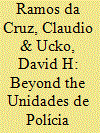

|
|
|
|
|
| Summary/Abstract |
Ten years ago, in 2008, the Brazilian Government adopted a strategy to regain control over the favelas in Rio de Janeiro – the Pacifying Police Units (UPP). In spite of initial favorable results, the main threat, namely the Red Command (CV), fought back and by 2014 the UPP strategy was badly frayed. In order to defeat this threat, it is necessary to reconceptualize CV as a criminal insurgency and to pinpoint and address the social and political factors that sustain it. This allows for a response inspired by the ‘shape-clear-hold-build’ counterinsurgency approach, which while cost-intensive is, in the long term, the most sustainable path to achieving security within the favelas and integrating these neglected areas within the broader city of Rio de Janeiro.
|
|
|
|
|
|
|
|
|
|
|
|
|
|
|
|
| 3 |
ID:
155198
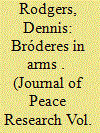

|
|
|
|
|
| Summary/Abstract |
Drawing on longitudinal ethnographic research that has been ongoing since 1996, this article explores the way that gangs socialize individuals into violent norms and practices in Nicaragua. It shows how different types of gang violence can be related to distinct socialization processes and mechanisms, tracing how these dynamically articulate individual agency, group dynamics and contextual circumstances, albeit in ways that change over time. As such, the article highlights how gang socialization is not only a variable multilayered process, but also a very volatile one, which suggests that the socialization of violence and its consequences are not necessarily enduring.
|
|
|
|
|
|
|
|
|
|
|
|
|
|
|
|
| 4 |
ID:
108349
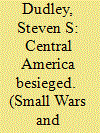

|
|
|
|
|
| Publication |
2011.
|
| Summary/Abstract |
The following is a threat assessment of the seven countries that make up Central America. That region is struggling to control burgeoning street gangs and organized criminal groups which have overrun its poor and ill-prepared security forces. The results are clear: rising crime and homicide rates throughout the region; corruption and instability within the governments. The two gangs that challenge authority are transnational in nature but pose less a threat to national security than they do to everyday life. Their drug peddling and extortion have shattered entire communities and forced the governments to reallocate important resources. The governments' strategy of jailing suspected gang members en masse has arguably made them stronger rather than weaker. Meanwhile, the organized criminal groups have deeply penetrated governments at nearly every level. They control swaths of territory, co-opting these areas, as well as the local governments, for their own purposes. Opposition to them is often futile. Mexican-based organizations are increasingly using violent tactics to displace their rivals. The governments of the region seem unprepared to meet the challenge.
|
|
|
|
|
|
|
|
|
|
|
|
|
|
|
|
| 5 |
ID:
188098
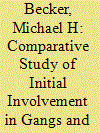

|
|
|
|
|
| Summary/Abstract |
There is a paucity of research comparing gang members and domestic extremists and extant studies find few explicit linkages. Despite this, there remains a great deal of interest in possible similarities between these criminal groups. Driving this interest is the possibility of adapting policies and practices aimed at preventing entry into criminal groups. A critical first step to determining compatibility is to examine the circumstances of the individuals who enter these organizations and better describe the entry processes. This study provides a unique comparison of entry into these groups by drawing on four broad empirically derived mechanisms of group entry using forty-five in-person interviews of U.S. gang members and thirty-eight life history narratives of individuals who radicalized in the United States. Our results reveal that each of the four conceptual categories appeared to influence initial involvement; however, no single mechanism described involvement in criminal groups or differentiated involvement across the gangs and extremist groups.
|
|
|
|
|
|
|
|
|
|
|
|
|
|
|
|
| 6 |
ID:
077334
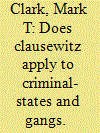

|
|
|
|
|
| Publication |
2006.
|
| Summary/Abstract |
Criminal-States and Criminal-Soldiers present unique problems for contemporary international political theory. This essay examines the applicability of the theory of war developed by Carl von Clausewitz to Criminal-States and Criminal-Soldiers. As modified by Aristotle's idea of justice as the basis for the political community, this essay proposes that Clausewitz's famous connection between politics and war holds where such states and soldiers evince political behavior. Some contrasting implications for states and state leaders are examined when such entities evince - and do not evince - political behavior
|
|
|
|
|
|
|
|
|
|
|
|
|
|
|
|
| 7 |
ID:
177674
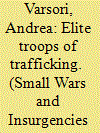

|
|
|
|
|
| Summary/Abstract |
In recent years, scholars and practitioners alike have acknowledged the threat posed by Military-Trained Gang Members (MTGMs). These individuals have the training, know-how, and expertise necessary to significantly increase the effectiveness and lethality of the armed group they belong to. Even though this threat is present in several criminal insurgencies, usage of the MTGM concept is limited to studies regarding the United States. This paper broadens this scope by assessing the presence and characters of the MTGM phenomenon in the city of Rio de Janeiro, Brazil. Through a review of media output on the topic, spanning over more than 21 years, the paper exposes the roots and extent of this trend, as well as the roles played by MTGMs.
|
|
|
|
|
|
|
|
|
|
|
|
|
|
|
|
| 8 |
ID:
134390
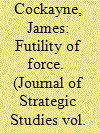

|
|
|
|
|
| Summary/Abstract |
Confronted by non-conventional non-state military forces enjoying high – but very localized – social legitimacy, the United Nations Mission in Haiti (MINUSTAH) struggled between 2004 and 2007 to embed the use of force in a larger strategy of state consolidation. The article explores the confrontations between MINUSTAH and unconventional armed groups in Haiti during this period. It traces MINUSTAH’s operations against criminal gangs, and the resulting process of strategic learning. It explores how tactical innovations allowed MINUSTAH to defeat the gangs, but also highlights that the larger political objective – breaking the connection between the gangs and Haiti’s political-business elite – remained unarticulated and elusive – and perhaps ultimately unfeasible, given the necessity of Haitian state consent for continued UN operations in the country. In a final post-script the article reflects on the return of the gangs after the earthquake of 12 January 2010, and what it signals about the limited impact of tactical force on the presence and power of political-criminal networks.
|
|
|
|
|
|
|
|
|
|
|
|
|
|
|
|
| 9 |
ID:
183920
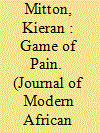

|
|
|
|
|
| Summary/Abstract |
Within two decades, Sierra Leone's ‘cliques’ have transformed from peripheral social clubs to warring Crips, Bloods, and Black street gangs at the heart of criminal and political violence. Nevertheless, they remain severely under-studied, with scholarship on Sierra Leonean youth marginality heavily focused on ex-combatants. Drawing on extended fieldwork with Freetown's cliques as they played the ‘game’ – the daily hustle to survive and resist the ‘system’ – this article offers two main contributions. First, it addresses the knowledge gap by charting the origins, evolution and contemporary organisation of these new urban players. Second, it argues that although this history reveals continuity in perennial forms of youth marginalisation, it also shows that the game itself has changed. Cycles of escalating violence and growth are hardwired into this new game. Exacerbated by a political system that sustains and exploits them, cliques present a far greater challenge to everyday peace than has hitherto been recognised.
|
|
|
|
|
|
|
|
|
|
|
|
|
|
|
|
| 10 |
ID:
077342
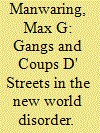

|
|
|
|
|
| Publication |
2006.
|
| Summary/Abstract |
The mutation of protean "street gangs" to insurgents illustrates that insurgents need not be ideologically oriented, and need not be traditional revolutionary fighters emerging from the mountains and jungles to take down or control a government. Rather, they may have their own specific commercial money-making motives, and can emerge out of the favelas, callampas, villas miserias, and pueblas jovenes (city slums) not so much to replace governments as to gain very lucrative freedom of movement and action within a supposedly sovereign national-state. Also, mature second and third generation gangs have been known to act as proxies and mercenaries for traditional nation-states that want to maintain "plausible deniability," and to act as mercenaries for warlords, organized criminal organizations, and/or drug-trafficking cartels that - on certain occasions - need additional "fire-power". The instability and lack of individual and state security generated by gangs phenomenon and their nefarious allies are also known to lead to the radical change of failed state status. In these terms, gangs are no longer a singular law enforcement issue. As crime and war become more and more indistinguishable, gangs must be considered a larger national security issue - that, paradoxically, must be viewed as a local concept
|
|
|
|
|
|
|
|
|
|
|
|
|
|
|
|
| 11 |
ID:
185746
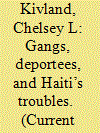

|
|
|
|
|
| Summary/Abstract |
Thousands of Haitian asylum seekers recently subjected to forced repatriation by the United States face a difficult time reintegrating in an unstable country which some of them hardly know. Adding to the difficulties are the prevalence of street gangs in Haiti and common assumptions that deportees are linked to organized crime.
|
|
|
|
|
|
|
|
|
|
|
|
|
|
|
|
| 12 |
ID:
092056
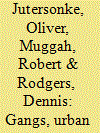

|
|
|
|
|
| Publication |
2009.
|
| Summary/Abstract |
Urban violence is a major preoccupation of policymakers, planners and development practitioners in cities around the world. Public authorities routinely seek to contain such violence through repression, as well as through its exportation to and containment at the periphery of metropolitan centres. Yet, urban violence is a highly heterogeneous phenomenon and not amenable to reified diagnosis and coercive intervention. Muscular state-led responses tend to overlook and conceal the underlying factors shaping the emergence of urban violence, as well as the motivations and means of so-called violence entrepreneurs. This is very obviously the case of urban gangs in Central America, which are regularly labelled a 'new urban insurgency' threatening the integrity of governments and public order. This article considers both the shape and character of Central American gang violence and attempts to reduce it, highlighting the complex relationship between these two phenomena. We advance a threefold approach to measuring the effectiveness of interventions, focusing in turn on discursive, practical and outcome-based criteria. In this way, the article demonstrates how, contrary to their reported success in diminishing gang violence, repressive first-generation approaches have tended instead to radicalize gangs, potentially pushing them towards more organized forms of criminality. Moreover, although credited with some modest successes, more preventive second-generation interventions seem to have yielded more rhetorical advances than meaningful reductions in gang violence.
|
|
|
|
|
|
|
|
|
|
|
|
|
|
|
|
| 13 |
ID:
108342
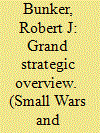

|
|
|
|
|
| Publication |
2011.
|
| Summary/Abstract |
This grand strategic overview highlights and analyzes the influence of epochal change on the state and conflict and the new realities with which the United States must now contend. This deep context is being provided so that (1) the belligerent and politicized non-state entities that have emerged in Mexico and the Americas can be better understood within the larger three-front grand strategic temporal conflict the US is now engaged in; and (2) the stark realities that the US faces - such as loss of unilateral world dominance, increasing debt and ongoing deficits, shifting demographics, inability to staunch the flow of and demand for illicit drugs, and an increasing prison population - are highlighted. Finally, this essay finishes with a discussion of the many important contributions contained in this edited work.
|
|
|
|
|
|
|
|
|
|
|
|
|
|
|
|
| 14 |
ID:
144085
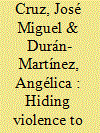

|
|
|
|
|
| Summary/Abstract |
In 2012, the two major street gangs in El Salvador, Mara Salvatrucha 13 and Barrio 18, struck a truce credited with reducing homicide rates by more than 50% in one year. Although the gang truce held for only 18 months, the significant reduction in homicides puzzled observers that believed youth gangs were unable to coordinate violence, especially considering that previous and similar efforts aimed at striking agreements did not achieve similar results. This article addresses a question posed by the puzzle of the Salvadoran truce’s success: under what conditions do negotiations between or with criminal organizations effectively reduce criminal violence? By comparing truces and criminal pacts in El Salvador and in Medellin, Colombia, we argue that criminal pacts can reduce homicides when (a) they directly involve the state as an administrator of incentives to reduce violence and (b) criminal organizations have achieved organizational cohesion and leadership that facilitate territorial control and strategic dependability. These conditions allow organizations to regulate violence. Our argument highlights the importance of how violence is performed and, more importantly, its visibility, to fully understand criminal behavior within pacts. It also points to potential lessons for countries seeking alternatives to reduce criminal and political violence in Latin America and elsewhere.
|
|
|
|
|
|
|
|
|
|
|
|
|
|
|
|
| 15 |
ID:
087518
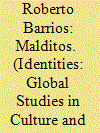

|
|
|
|
|
| Publication |
2009.
|
| Summary/Abstract |
Since the mid-1980s, street gangs known as maras have emerged as a new social entity in Central America. In Honduras, these informal organizations are repeatedly represented in various forms of media as an aberration that is clearly separate from populace and state. Such representations render mareros as entities that possess a radically alien ontology, which is the sole locality of intervention of anti-mara programs. This article analyzes popular media and ethnographic observations to demonstrate that a) rather than being an alien ontology, marero subjectivities are co-constituted through nation and class-forming practices and b) despite such representations, Hondurans of various walks of life routinely subvert attempts to create a tripartite body politic of state-populace-marero. Continued emphasis on the marero as the sole site of intervention and rehabilitation deals with the mara issue at a symptomatic level and fails to address the quotidian processes that give form to this phenomenon.
|
|
|
|
|
|
|
|
|
|
|
|
|
|
|
|
| 16 |
ID:
077341
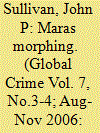

|
|
|
|
|
| Publication |
2006.
|
| Summary/Abstract |
Third generation street gangs are a crime and security problem in many global cities, internationally linked ethnic Diasporas, and cross-border regions where insecurity and criminal non-state actors reign. Widely known as third generation gangs (3 GEN Gangs), complex gangs operate with broad reach - often across borders - and can develop mercenary and at times political and potentially terrorist objectives. The typology of the three generations of gang evolution (based on the interaction of politicization, internationalization, and sophistication) is recounted, recent trends in transnational street and prison gangs are explored and future potentials are suggested.
|
|
|
|
|
|
|
|
|
|
|
|
|
|
|
|
| 17 |
ID:
140340
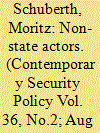

|
|
|
|
|
| Summary/Abstract |
The proliferation of irregular armed actors which defy simplistic definition has caught public and academic attention alike, not least in the pages of this journal. To move the debate on non-state armed groups (NSAGs) forward, this article seeks to enhance our conceptual understanding of parochial armed groups which are not primarily driven by ideological or religious objectives. Thus, this article clarifies similarities as well as differences between subtypes of community-based armed groups (CBAGs) on the one hand, and between CBAGs and other NSAGs, on the other hand. By doing so, a typology is developed that classifies militias, gangs and vigilantes on the basis of their political, economic and security-related dimensions. The resulting ideal types are discussed through the lenses of different explanatory frameworks and policy debates in the field of contemporary security studies. A major typological issue is the tendency for CBAGs to ‘turn bad’ and become threats to the stability they were expected to transform, becoming a serious problem in countries where they operate. It is concluded that the challenge of CBAGs ultimately needs to be addressed by putting in place a functioning state that can tackle the underlying woes that led to their proliferation in the first place.
|
|
|
|
|
|
|
|
|
|
|
|
|
|
|
|
| 18 |
ID:
109856
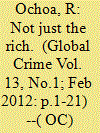

|
|
|
|
|
| Publication |
2012.
|
| Summary/Abstract |
This article explores the development of kidnapping in Mexico City. New evidence suggests that this crime has evolved from a crime that until recently targeted mostly the wealthy to one that now targets mainly middle- and working-class individuals. This is counterintuitive since, arguably, kidnapping is a costly crime to plan and execute and is thus better suited for a once-off large payoff. Typical explanations of high crime rates and other criminal phenomena in Latin America argue that either a weak state or very powerful criminals explain high levels of crime and violence. I argue for a middle-ground approach that looks at the interactions between state, criminals and society to explain the changes mentioned. Using qualitative evidence, I explain this shift in kidnapping along three lines: (1) the successful destruction by the state of older, sophisticated kidnapping gangs; (2) the formal and informal strategies that wealthy individuals designed and implemented to protect themselves from crime; and (3) the failure of the state to impose a strong rule of law. The article concludes by reflecting on the importance of deep structural reform as a way to assure long-lasting drops in crime.
|
|
|
|
|
|
|
|
|
|
|
|
|
|
|
|
| 19 |
ID:
159864
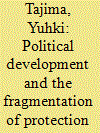

|
|
|
|
|
| Summary/Abstract |
Why do gangs proliferate during democratization and decline in number during authoritarian consolidation? I utilize primary evidence of two Indonesian gangs to inform a model of protection gangs under varying states of political development. Modeling gangs as territorial firms under different regulatory conditions, I attribute their number and political affiliation to the interaction between state capacity and political fragmentation. In weak states, gangs will lack political affiliations and their number will be determined by the scalability of their coercive capacities. In countries where states have the capacity to significantly constrain gangs, but lack significant costs for politicians to associate with them, gangs will seek political affiliation, trading coercive services for lax law enforcement. In such contexts, their number will be determined by state factionalization. Thus, gangs proliferate during democratization due to more political actors sharing state control. I assess the theory examining Indonesia’s history of statebuilding and political transition.
|
|
|
|
|
|
|
|
|
|
|
|
|
|
|
|
| 20 |
ID:
187557
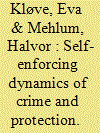

|
|
|
|
|
| Summary/Abstract |
This article presents a model describing a symbiotic relationship between criminals and a partnership of protection providers, called the Firm. The partners of the Firm earn profits as they have market power in the supply of protection. The Firm recruits its new partners among criminals. As a result, the prospect of graduating to the Firm adds an incentive for violent crime. The result is a violence multiplier where more violence increases the profits to the partners of the Firm, in turn contributing to the incentive for violence. The violence multiplier also generates an incentive for the protection providers to welcome new partners, even though new partners dilute the profits. The model combines elements from contest theory and rent-seeking theory but, nevertheless, generates results that are in contrast to standard results from the rent-seeking literature. For example, due to the interdependence between protection providers and criminals, a decrease in the cost of violence increases violence more than pari passu and increases the value of being a criminal. Also, tougher competition between criminals may benefit all of them. The empirical relevance of key elements of this framework are confirmed by exploring unique data on incarcerated youth in South Africa. The empirical results confirm a hierarchical gang structure and indicate that this structure does indeed promote violence.
|
|
|
|
|
|
|
|
|
|
|
|
|
|
|
|
|
|
|
|
|